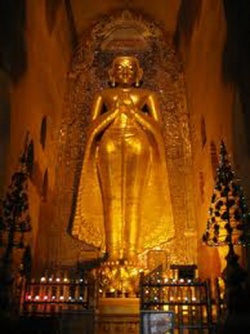Vaibhāṣika
The Vaibhashikas (Skt. Vaibhāṣika; Tib. བྱེ་བྲག་སྨྲ་བ་ , chedrak mawa; Wyl. bye brag smra ba) or ‘proponents of differences’ are so-called because they base their tenets on the text called Mahavibhasha (Tib. བྱེ་བྲག་བཤད་མཛོད་ཆེན་མོ་, Wyl. bye brag bshad mdzod chen mo), and/or because they posit the past, present and future as distinct and substantially existent temporal categories.
==The Vaibhashika View of the Two Truths==
Khenpo Ngakchung says:
The Abhidharmakosha says:
Things which, when destroyed or mentally dissected,
Can no longer be identified by the mind,
Such as pots or water, are relative;
All else besides is ultimately existent.
Treasury of Abhidharma, VI, 4
Source
RigpaWiki:Vaibhāṣika
As this says, any coarse thing which can be smashed to pieces with a hammer or dissected into parts by the mind, so that the mind which apprehended that coarse appearance no longer identifies it as such, belongs to the relative truth. Then concerning the absolute, any coarse material thing or state of consciousness can be broken down into its ultimate constituents, which are individual particles or moments. Therefore the partless particles, which are the ultimate constituents of coarser things, and the indivisible moments of consciousness, which are the ultimate constituents of mental phenomena, are said to be absolute truth.
===Other Tenets===
- They categorize phenomena according to the five basic categories of knowable phenomena.
- They reject the idea that consciousness knows itself. The consciousnesses perceive their objects by means of their respective sense faculties directly without any images (or representations or mental features or aspects) (Tib. རྣམ་པ་, Wyl. rnam pa).
- Characteristics such as arising, dwelling and ceasing are believed to exist in a way that is distinct from the entities they characterize.
- They say that 'inexhaustible substance' is the basis for karma.
==Alternative Translations==
The Vaibhāṣika was an early Buddhist subschool formed by adherents of the Mahāvibhāṣa Śāstra, comprising the orthodox Kasmiri branch of the Sarvāstivāda school. The Vaibhāśika-Sarvāstivāda, which had by far the most "comprehensive edifice of doctrinal systematics" of the early Buddhist schools, was widely influential in India and beyond.
The school was originally of a mystical nature, later developing into more materialistic concerns with a focus upon Materialism and 'existent phenomena' (Tibetan: yod-pa). The key tenets of this school are "that no mental concept can be formed except through direct contact between the mind, via the senses, such as sight, touch, taste, etc., and external objects".
Berzin (2007) elaborates this further:
Vaibhashika asserts sensory nonconceptual cognition of an object through direct contact with it, without the medium of a mental aspect of the object. Because of that, when something made of parts is validly known, the cognition must simultaneously also take as its objects the parts on which the object depends.
Nomenclature and etymology
Vaibhashika or Vaibhasika (Sanskrit). (Tibetan: bye-brag smra-ba).
Context
Berzin (2007) discusses and contextualises Vaibhashika in relation to the eighteen Hinayana schools, the Sautrantika, the Sarvastivada:
Within the eighteen Hinayana schools, the Vaibhashika and Sautrantika belong to Sarvastivada (thams-cad yod-par smra-ba), a Sanskrit tradition, different from the Pali Theravada tradition (gnas-brtan smra-ba). The Tibetan lineage of monastic vows comes from another of its sub-schools, Mula-sarvastivada (gzhi thams-cad yod-par smra-ba).
Nava Vihara and Vaibhashika have entwined histories. Nava Vihara emphasized the primary study of the Vaibhashika abhidharma, admitting only monks who had already composted texts related to the topic.
Mipham (1846–1912), discusses the Vaibhashika school in his purport to Verse 3 of Śāntarakṣita's Madhyamākalaṃkāra, an extract of this discussion rendered into English by the Padmakara Translation Group (2005: p. 165) follows:
The Buddhist Vaibhashika school asserts three uncompounded entities, which are truly existent and permanent (rtag dngos). The first of these is space. The second is nonanalytical cessation, or absence. This term refers not to a cessation that occurs through the application of analysis or understanding but to the fact that when something is not present, owing to the absence of some of the natural conditions that would normally produce it, this very absence is regarded as an uncompounded entity that precludes the appearance of the thing in question. And this is therefore called a non-analytical cessation or absence (brtags min 'gog pa). The Vaibhashikas claim that this uncompounded entity is a really existent thing. The third uncompounded entity is analytical cessation--the cessation that arrises through analysis or understanding (so sor brtags 'gog pa), referring to the absence of defilements that results from the practice of the path. The Vaibhashikas ascribe real, "substantial" existence to this as well. .

